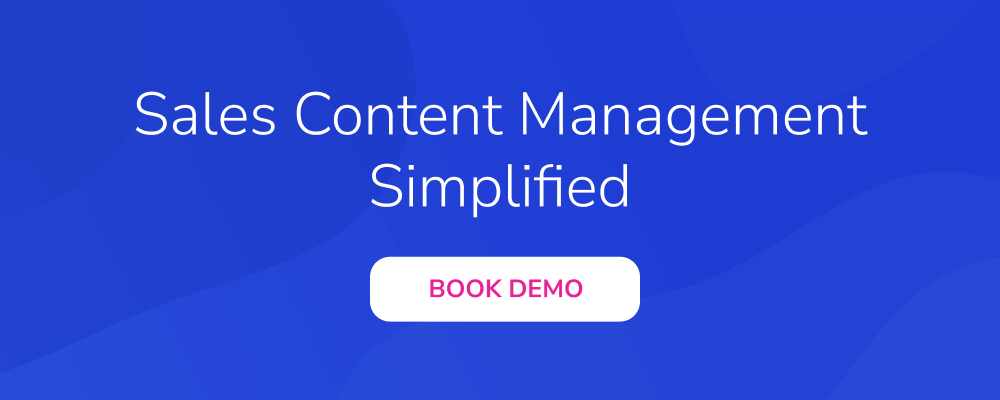Effective sales content management greatly impacts the way your sellers sell. It can greatly improve various aspects of your sales process - sales efficiency, customer engagement, brand consistency, and overall sales performance.
Essentially, the concept of sales content management seems as simple as storing and organizing files. However, with a strategic approach that can exponentially simplify how your sales reps find, use, and share sales materials.
What you'll find in this blog:

What is Sales Content Management?
Sales content management refers to the process of organizing, storing, and distributing sales-related materials. These sales-related materials can be your sales presentations, product brochures, proposals, service configurators, and so on.
As the workforce shifts to a hybrid setting, it calls for a stronger sales content management tool to maintain business as usual. Your teams should have easy access to the right information every time, without fail, wherever they may be.
|
💡 With a centralized system for storing and accessing your sales materials, your team can easily find the resources they need to succeed, freeing them up to focus on what they do best: selling. Read more about What is the Best Way to Provide Content to Your Sales Team? |
Role of Sales Content Management in Sales and Marketing
According to this report from Salesforce, 60% of professionals say that a collaborative approach with different departments when it comes to selling has increased their productivity by more than 25%.
“Suppliers that provide consistent information across both sales reps and their website see a 25% improvement in the number of high-value, low-regret deals.”
Source: Gartner
The buying journey is becoming more complex day by day and sales content can help solve the complexities in the modern B2B buying journey.
By having a collaborative approach to sales, a system that connects your customers, employees, partners, and products, you get a complete picture of the buyer’s journey. Working in silos is becoming obsolete in modern sales. So, where does sales content management fit in the picture?
Sales Content Management for Marketing
A customer touchpoint is any interaction a buyer has with your brand– a website visit, an ad click, an email newsletter open, and so on. You may notice that almost every customer touchpoint is centered around some form of content.
This is because marketers make prospects aware of your product or service, deliver key value points of the product, and convert prospects into customers.
Marketers are typically the content owners in a B2B organization. They ensure that for every touchpoint, the buyer gets a consistent look and feel of the company whether that is before, during, or after purchase.
Sales content management ensures that for every content, this is achieved across the organization. With a sales content management system that streamlines the content creation and distribution process, marketers are enabled to maintain messaging and brand consistency.
Equipped with tracking and analytics, marketers can see which content is effective and which ones need further refinement.
A sales content management tool acts as a central repository for all of your content, regardless of file type. You can set permissions and user groups, to teams can only access information that is relevant to them.
This allows marketers to keep sales content accurate, up-to-date, and brand-compliant.
Equipped with tracking and analytics, marketers can see which content is effective and which ones need further refinement.
Sales Content Management for Sellers and Sales Leaders
G2 found that sales reps spend an average of 440 hours each year just searching for relevant sales content. That significant amount of time is an opportunity cost for the business, simply because of poor sales content management.
A sales content management platform allows your sales team to easily find and access relevant information they need to engage with their prospects, virtually or face-to-face. The analytics that comes with these tools also allows you to see which content is being actively used by your sellers, so you can better adapt your sales tactics.
According to the same report, 66% of sales reps find major benefits in using a mobile sales app. Even more convenient that sales content management tools can now easily integrate with your existing systems and are available to use offline on any device.
"Shaping your content to align with the buying journey allows your sellers to have more strategic conversations, and increases their likelihood of moving the deals forward by 2.8x."
Source: Gartner
A sales content management software resolves can help you achieve that and resolve the main issues that revolve around managing sales collaterals.
Key Features of a Sales Content Management Tool
There are various sales content management solutions available in the market. But here are the most common and essential functionalities, which Showell offers, that you and your teams can highly benefit from:
1. Centralized content repository
The main functionality of a sales content management solution and most important: a centralized content repository. Just like Showell, it allows you to store all of your content in one place for the ultimate ease of access.
Your sellers no longer have to dig through old emails or cloud storage systems to find the most up-to-date materials. Access and store anything and everything you need including videos, 3D designs, PDFs, images, and more, together under one single platform.
2. Organize files and folders how you see fit
Don’t adapt your needs to the tool, but make your tool adapt to your needs. With Showell, you can easily organize files and folders to reflect the structure you and your teams prefer: by region, product, persona, or stage in the sales journey.
Every sales material has a place and purpose, so you eliminate any ambiguous content. And salespeople are only using materials that are proven to be effective bases on data.
3. Access permissions and user groups
A sales content management solution is not only to provide structure to your files and folders but also so you can organize who can access particular sets of content. With Showell, you can create user groups to decide who can access what content and perform specific actions.
This eliminates having to create different content repositories for different teams. Content can now live in one place, and roles can be assigned.
4. Version control and device synchronization
You no longer have to individually edit and update content or send out updated materials to your sellers, partners, and dealers every time you make any changes. When you edit content from Showell, it simultaneously updates from across all of your users’ devices.
After you make changes, you can easily send push notifications to your users to update them on any changes. You are guaranteed that your team is using only the most current version of sales materials.
|
💡 Sellers having unhindered access to the relevant materials translates to increased sales efficiency, allowing them to focus on building relationships and closing deals. Learn more about Content Hub, Empowered Sellers: Digital Content Management for Sales. |
Showell: Sales Enablement as a Sales Content Management Tool
Gartner defines sales enablement as the process of providing your sale team with information, content, and tools to help them sell effectively. And tools like sales enablement enables your salespeople to be more efficient when it comes to finding and sharing materials with prospects.
Sales enablement tools like Showell eliminates having to manage content in siloes. You can centralize, organize, synchronize, and authorize your sales collateral, all from Showell. Aside from its content management feature, your seller can also easily share and track sales materials.
Showell connects disparate systems for a streamlined sales process and to provide a seamless experience for your buyers.
4 Common Pitfalls Of Poor Sales Content Management
The main objective of a sales content management tool is to eliminate the most common obstacles that your sellers face when they sell. To see the impact of poor sales content management on your business, let’s look into its most common pitfalls and how sales enablement tools like a sales content management tool can resolve these issues.
Scattered sales materials
Imagine a busy sales team working on a new product launch. They are all eager to promote the product and have been given a range of marketing materials, including brochures, flyers, and product samples.
However, because they are all working remotely, the sales team members are storing these materials on their computers or in different online folders. As a result, there is no centralized location for these materials, and team members are struggling to find the latest versions. They end up sending out different versions of the same materials, causing confusion among potential customers and creating a disjointed sales experience.
With a sales enablement tool, not only is all your content stored in one place, but relevant sales materials can be organized so that only relevant and up-to-date materials are accessible to respective teams.
This is a common scenario that occurs without a well-structured sales content management system. With a sales enablement tool, not only is all your content stored in one place, but relevant sales materials can be organized so that only relevant and up-to-date materials are accessible to respective teams.
|
💡 While you can undoubtedly ping a message to your teams quickly, a little more finesse is required for sales content. Without a content hub and sales enablement tool, your marketing materials could just be sitting there or missing the mark time after time. Read more about 10 Daily Inefficiencies You’ll Experience Without a Sales Enablement Tool. |
Inaccuracies and inconsistencies with your content
It’s only best practice to regularly update your sales materials, especially if you track and measure how your buyer engage and consume your content. This task can be tricky to manage and scale without the right tools.
Updating your content is an extremely time-consuming process without a sales content management tool. This is especially the case if you also store your material in multiple content repositories. Eventually, a document or two will be bound to contain inaccurate information and this issue can easily multiply to the point that version control is no longer possible.
With a sales content management tool like Showell, you’ll rest assured that any content changes or updates reflect simultaneously across all of your sales reps’ and dealers’ devices. Not only are you saving a significant amount of time updating and managing your sales materials, but your sellers are guaranteed to find only the current versions of any content.
|
💡 Timely and applicable content targeted at the appropriate potential buyer is a potent tool for companies to keep prospects engaged and stimulated while they navigate the sales funnel. Here are 5 Ways Sales Content Management Software Improves Content Performance. |
Difficulty accessing content
Content accessibility is another common issue that your sellers face. If your content is not easily accessible to your salespeople, you risk your sellers going into meetings unequipped with the right materials to effectively engage with prospects.
In turn, this can lead to them creating their own content, which results in inconsistent messaging, diluted brand, compliance risk, and disconnected buyer experience. These issues can negatively impact your sales and overall revenue.
Providing your sellers with a platform where they can easily access materials relevant to them helps them to be more efficient and significantly effective in their roles.
System and tool integration challenges
Depending on your organization’s existing processes, it might be the case that a sales content management system will replace your current tech stack. But most of the time, sales content management tools are meant to complement and bring synergy to your existing system.
This allows you and your teams to focus your time and effort on revenue-generating activities and letting technology do what it does best.
Without a content management solution in place, you might find difficulties integrating with commonly used sales tools. This can hinder you and your teams from scaling and becoming efficient as your pipeline grows. As you scale, the tools and systems you use should adapt with the growth to automate and streamline menial sales tasks.
This allows you and your teams to focus your time and effort on revenue-generating activities and letting technology do what it does best. To do that, it’s worth investing in a sales content management solution.
5 Best Practices For An Effective Sales Content Management
Follow these five best practices to make your sales content management more effective:
1. Create buyer-focused sales content
Start by defining your sales content strategy. Identify and align what types of content you will create, who your target audience is, and how you will distribute and measure the effectiveness of your content. Gartner says in this report that:
Good sales content can help to overcome these buying journey steps:
- Problem identification
- Solution exploration
- Requirements building
- Supplier selection
- Validation
- Consensus creation
Key Stages of the Buyer's Journey: Activities and Sales Materials Needed
|
Stage |
Activity |
Types of Materials Needed |
|
1. Awareness |
Identifying a problem or need |
Informational content, educational materials, social media posts |
| 2. Consideration |
Exploring possible solutions |
Product brochures, whitepapers, case studies, comparison charts |
|
3. Evaluation |
Comparing suppliers and products |
Product demonstrations, customer testimonials, competitive analysis |
|
4. Decision |
Making a purchase decision |
Pricing information, implementation plans, incentives/promotions |
|
5. Validation |
Confirming the right choice |
ROI analyses, proof of concept results, industry certifications |
|
6. Consensus Creation |
Gaining buy-in from stakeholders |
Executive summaries, high-level presentations, objection handling materials |
|
7. Onboarding & Implementation |
Implementing and using the product |
Training materials, user guides, ongoing support resources |
|
8. Retention & Advocacy |
Maintaining the relationship, creating advocates |
Ongoing communication, newsletters, customer success stories |
2. Organize content in a centralized content library
Once your strategy is set, build a centralized content library that includes all of your sales content, including product information, case studies, sales decks, and customer testimonials. Make sure the sales content tool is easy to navigate, search and structure files with, and has tracking capabilities.
Organize your content into a structure that would cater best to your sales process. This will make it easier for sales reps to find the right content for their needs. Consider adding tags and keywords to improve sales content’s searchability.
3. Keep content up-to-date
Make sure your content is up to date and reflects the latest product features, pricing, and messaging. Assign ownership of content to a specific team to ensure accountability for keeping it current.
4. Track and measure your sales content performance
To ensure that your content is always relevant to your buyers, track and measure how they engage and interact with your sales materials. With the insights you get from the sales content analytics, you can identify any gaps and room for improvement in your content.
5. Provide training and support
Train your sales reps on how to use the content library effectively and provide ongoing support to ensure that best practices are being followed. Sales content management is one of those processes that, once you get the hang of it, should be easier to scale.
But it’s also one of those tasks that once you start to divert from the best practices, it’s easy to fall back into old, ineffective practices.
Summary
Managing your sales content effectively can have a huge impact on your sales process. It can improve your sales efficiency, customer engagement, brand consistency, and overall sales performance.
There are many sales content management solutions available, but some essential features to look for include:
- A centralized content repository
- Flexible file and folder organization
- Access permissions and user groups.
By investing in a sales content management tool like Showell, you can streamline your sales process, improve collaboration, and ultimately drive more sales. Book a demo with us to see it in action.
Learn next:






